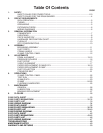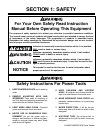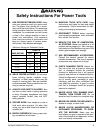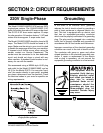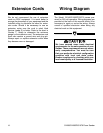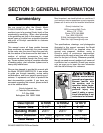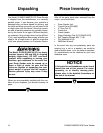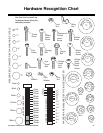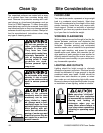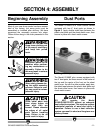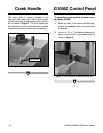
G1066/G1066Z/G1079 Drum Sander -5-
SECTION 2: CIRCUIT REQUIREMENTS
220V Single-Phase
The Model G1066/G1066Z/G1079 features 220V
single-phase motors. The G1066/G1066Z 5 HP
motor will safely draw about 25 amps under load.
The G1079 2 HP drum motor requires 12 amps
for safe operation. All sanders feature
1
/4 HP feed
motors that draw approx. 3 amps under load.
The Model G1066/G1066Z should be fused at 30
amps. The Model G1079 should be fused at 15
amps. Make sure the wiring in your circuit is rated
to handle the amperage draw from your machine.
If frequent circuit failure occurs when using the
sander, contact our Service Department. The
sander must be connected to its own dedicated
circuit and should not share a circuit with any
other machine. A standard 2-pole breaker is nec-
essary for use with the sander.
We recommend using a NEMA-style L6-30 plug
and outlet for the Model G1066/G1066Z, and an
L6-15 for the Model G1079. You may also “hard-
wire” the sander directly to your panel, provided
you place a disconnect near the machine. Check
the electrical codes in your area for specifics on
wiring requirements.
Figure 1. Typical plug configuration for 220V,
single-phase operation.
Grounding
In the event of an electrical short, grounding
reduces the risk of electric shock by providing a
path of least resistance to disperse electric cur-
rent. This tool is equipped with an electric cord
that has an equipment-grounding conductor
which must be properly connected to a grounding
plug. The plug must be plugged into a matching
outlet that is properly installed and grounded in
accordance with all local codes and ordinances.
Improper connections of the electrical-grounding
conductor can result in the risk of electric shock.
The conductor with green or green and yellow
striped insulation is the electrical-grounding con-
ductor. If repair or replacement of the electric
cord or plug is necessary, do not connect the
equipment grounding conductor to a live terminal.
This equipment must be
grounded. Verify that any
existing electrical outlet
and circuit you intend to
plug into is actually
grounded. Under no cir-
cumstances should the
grounding pin from any
three-pronged plug be
removed. Serious injury
may occur.







